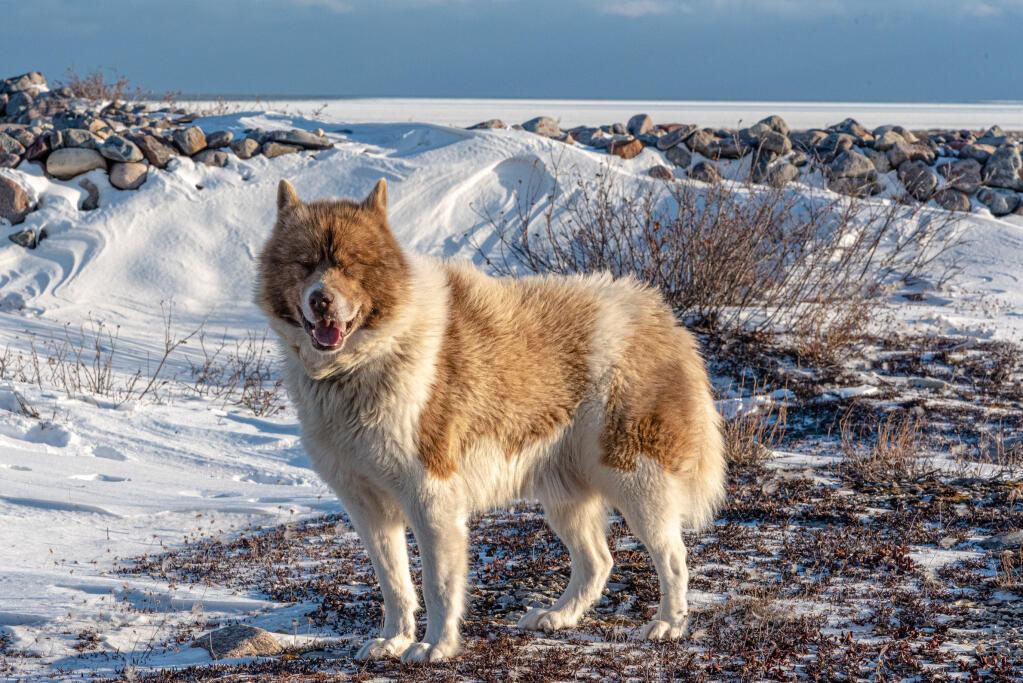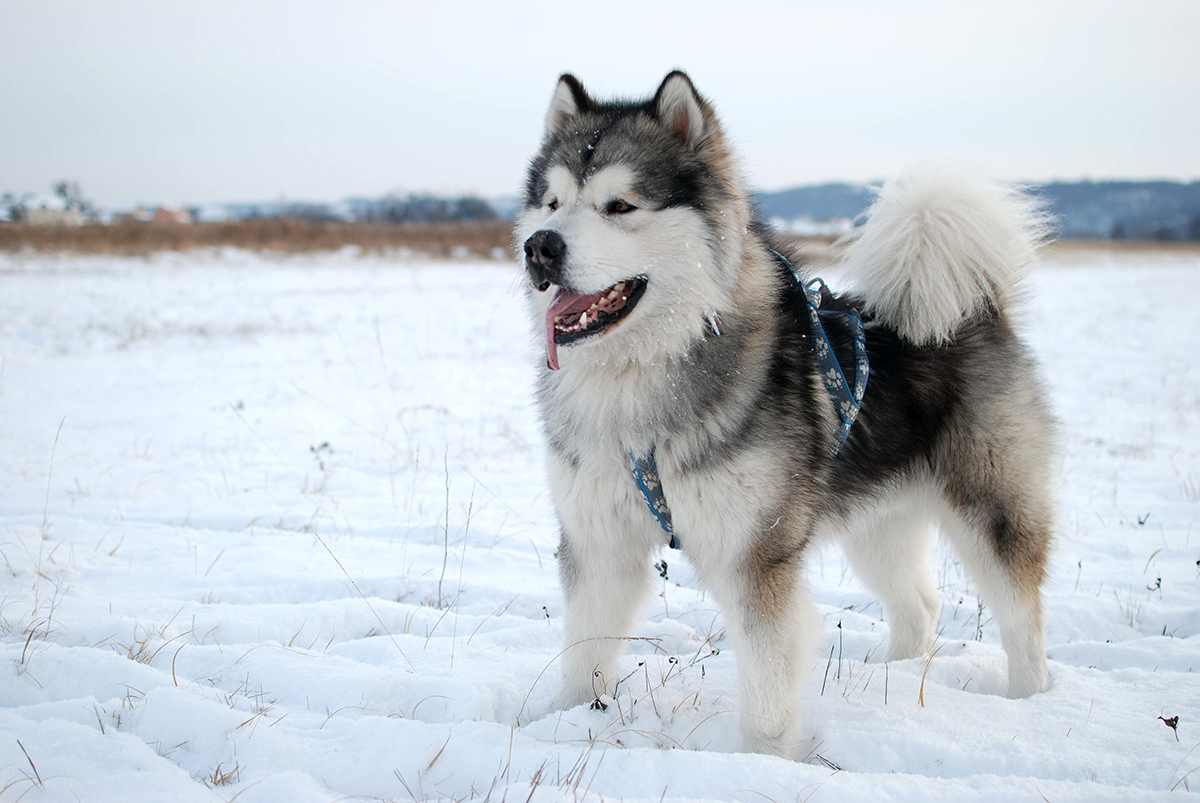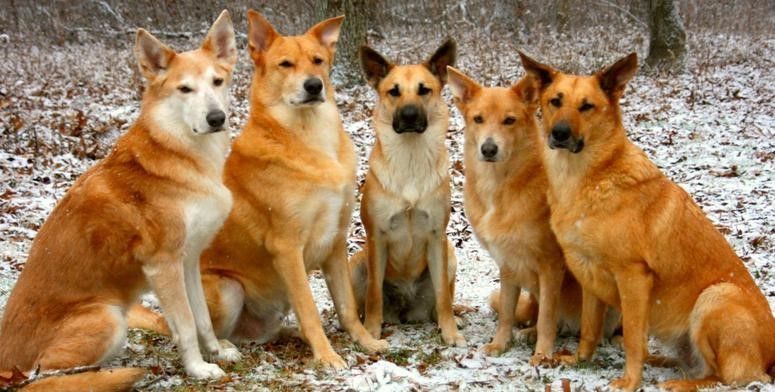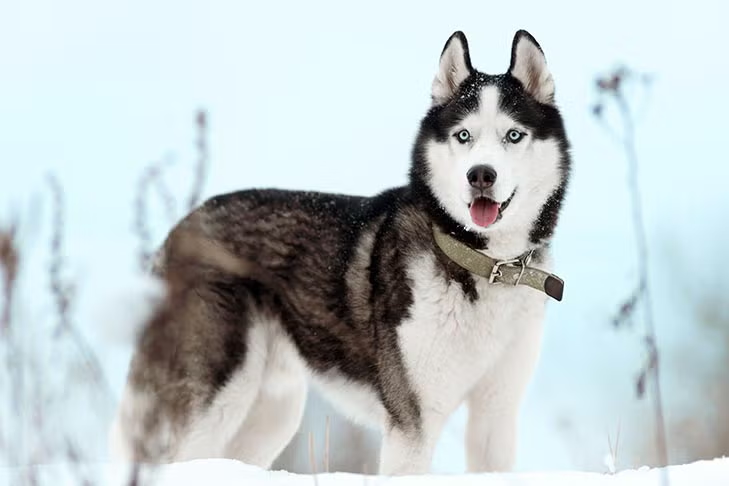Introduction: Meet Canada’s Ancient Indigenous Canine
So you think you know about rare dog breeds? Let me introduce you to one of North America’s oldest and most endangered canine treasures: the Canadian Eskimo Dog. With fewer than 300 purebred specimens remaining worldwide, this magnificent Arctic working dog isn’t just rare—it’s literally fighting for its survival as a breed.
Picture this: a powerful, wolf-like dog with a thick coat, an impressive mane, and the ability to pull sleds across frozen tundra for hundreds of miles in blizzard conditions. That’s the Canadian Eskimo Dog (also known as the Canadian Inuit Dog or “Qimmiq” in Inuktitut) in a nutshell. But this breed is so much more than just its impressive physical capabilities—it’s a living piece of Indigenous history and culture.
While scrolling through Instagram dog accounts showcasing French Bulldogs and Golden Retrievers is cute, I’ve become completely fascinated by this ancient breed that has served as a working partner to the Inuit people for thousands of years. The Canadian Eskimo Dog represents a unique relationship between humans and canines that developed in one of the harshest environments on Earth.
Whether you’re a dog breed enthusiast, history buff, or just curious about unusual animals, the story of the Canadian Eskimo Dog is absolutely worth knowing. From their ancient origins to their near-extinction and current conservation efforts, let’s dive into everything that makes this Arctic canine so special—and why their survival matters.
Ancient History: 4,000 Years of Arctic Partnership
The Canadian Eskimo Dog has one of the longest histories of any domesticated dog breed in North America, with archaeological evidence suggesting they’ve been working alongside humans for at least 4,000 years—possibly even longer. This makes them one of the oldest indigenous dog breeds in existence, a true living artifact of ancient human-canine partnerships.
The breed’s origins are closely tied to the migration of the Thule people (ancestors of modern Inuit) who arrived in North America from Siberia around 1,000 years ago. These Arctic settlers brought with them specialized dogs adapted for survival and work in extreme cold conditions. DNA studies have confirmed that today’s Canadian Eskimo Dogs are direct descendants of these ancient working canines, with minimal genetic change over the centuries.
What’s fascinating about the Canadian Eskimo Dog’s development is how little human-directed selective breeding played a role. Unlike many modern breeds that were created through intensive selection for specific traits, the Canadian Eskimo Dog evolved naturally in response to the demands of Arctic survival. The harsh environment itself shaped the breed—only the strongest, most cold-resistant, and most efficient working dogs survived to pass on their genes.
For thousands of years, these dogs were absolutely essential to Inuit survival. They served multiple critical roles: pulling sleds loaded with supplies across vast distances, helping to locate seal breathing holes in the ice during hunts, holding polar bears at bay while hunters approached, and even providing warmth in emergencies. The relationship between the Inuit and their dogs was primarily utilitarian—these were working animals rather than pets—but the partnership was based on mutual dependence in an unforgiving landscape where cooperation meant survival.
Interestingly, unlike many other indigenous cultures, the traditional Inuit view didn’t place these dogs in the category of “animal” (uumajuit) but rather saw them as tools for human existence. This pragmatic approach influenced how the dogs were treated and trained, with an emphasis on developing tough, hardworking animals rather than companions.
The breed’s history took a dramatic turn in the early 20th century when Arctic explorers discovered the exceptional capabilities of these dogs. Famous explorers including Robert Peary and Roald Amundsen used Canadian Eskimo Dogs extensively in their polar expeditions. The dogs’ incredible endurance, cold tolerance, and working ability helped these explorers make history—reaching both the North and South Poles with the assistance of these remarkable animals.
Physical Characteristics: Built for Arctic Survival
The Canadian Eskimo Dog’s appearance immediately tells you this is a canine built for serious work in extreme conditions. There’s nothing delicate or ornamental about this breed—every aspect of their physical makeup serves a purpose for Arctic survival and functionality.
Let’s start with size and build. These are substantial dogs, with males standing 23-28 inches at the shoulder and weighing 65-105 pounds. Females are somewhat smaller but still impressive at 20-24 inches and 60-95 pounds. What’s most striking is their powerful, muscular physique that clearly communicates strength rather than speed. They have deep chests, sturdy legs, and strong backs—all adaptations for pulling heavy loads over long distances.
Their head is broad and wedge-shaped, with small, triangular ears that stand erect—a classic spitz-type characteristic that minimizes heat loss in cold environments. Their almond-shaped eyes can range from dark brown to amber (blue eyes are considered a sign of mixed breeding) and carry an alert, intelligent expression. If you look at their face, you might notice a superficial similarity to wolves—something that early Arctic explorers frequently commented on.
What truly defines the Canadian Eskimo Dog’s appearance is their magnificent coat. They have a classic double-layer arrangement: a dense, soft undercoat for insulation paired with longer, coarser guard hairs that provide protection from the elements. This combination creates a weatherproof system that allows them to comfortably sleep outdoors in temperatures far below freezing. Males typically develop a more pronounced mane around the neck and shoulders, adding to their imposing appearance.
The coat comes in various colors and patterns, with no specific color being preferred in the breed standard. They can be solid white, black, gray, red, or any combination of these colors. Many have distinctive facial markings or “masks” that add to their wolf-like appearance.
Their tails are another distinctive feature—thick, bushy, and carried over the back in a curved position when the dog is alert or moving. Historically, this tail served as a crucial adaptation, allowing the dog to cover its nose and face when sleeping in the snow, preserving body heat.
One physical characteristic that might not be immediately visible but is equally important is their efficient metabolism. Canadian Eskimo Dogs evolved to work hard with minimal food—a crucial adaptation in an environment where resources were scarce. Their bodies are exceptionally efficient at converting nutrition into energy, allowing them to maintain strength and endurance even during periods of limited food availability.
Finally, their movement style reflects their working heritage. They have a smooth, powerful gait that covers ground efficiently without wasting energy—perfect for the long-distance sledding that was their primary job for thousands of years.
Temperament: Independent Working Spirit
Understanding the Canadian Eskimo Dog’s temperament requires appreciating their heritage as working dogs in one of the world’s most challenging environments. These aren’t your typical companion dogs—they’re intelligent, independent canines bred for specific tasks and survival in harsh conditions.
First and foremost, these dogs are pack-oriented. For centuries, they worked in teams pulling sleds, and this instinct remains strongly ingrained. They have a clear sense of pack hierarchy and will establish dominance relationships with other dogs. This pack mentality extends to their human family—they need clear leadership and consistency.
Intelligence and problem-solving ability are hallmarks of the breed. Canadian Eskimo Dogs needed to make independent decisions while working in treacherous Arctic conditions, and this self-sufficiency is still evident in their behavior today. They’re capable of assessing situations and taking action without constant direction.
With their human family, Canadian Eskimo Dogs can be affectionate and loyal, forming strong bonds with those they consider part of their pack. They can be particularly good with children when properly socialized, showing patience and gentleness that might seem surprising given their working background. This adaptability with family members likely stems from their historical close living arrangements with Inuit families, where dogs would often share living spaces during the harshest weather.
However, their attitude toward strangers and unfamiliar dogs requires careful management. While not typically aggressive toward unknown people, they can be aloof and reserved. With dogs outside their established pack, they may show dominance or aggression—a trait that served them well historically when resources were scarce, but requires careful handling in modern settings.
Perhaps the most challenging aspect of their temperament for modern owners is their high energy level and need for purpose. These dogs were bred to run and work for hours every day in demanding conditions. Without adequate physical exercise and mental stimulation, they can become bored, frustrated, and destructive. They need an outlet for their working drive—whether that’s recreational sledding, skijoring, backpacking, or other demanding activities.
Vocalization is another distinctive trait. Canadian Eskimo Dogs rarely bark but are known for their howling—a hauntingly beautiful sound that connects them to their ancient origins but might not endear them to close neighbors.
It’s worth noting that while these dogs are trainable, they respond best to confident, consistent leadership rather than harsh methods. Their independent nature means they won’t blindly obey commands that don’t make sense to them, and they can be stubborn when they believe they know better. Training requires patience, respect for their intelligence, and an understanding of their working heritage.
The Brush with Extinction: A Breed Nearly Lost
The story of the Canadian Eskimo Dog includes a dark chapter that nearly meant the end for this ancient breed. Despite thriving for thousands of years and reaching population numbers estimated at around 20,000 in the early 20th century, by the 1970s, the breed had dwindled to fewer than 200 individuals—placing them at the brink of extinction.
What caused such a dramatic decline? The answer involves a complex mix of technological change, cultural shifts, and controversial government policies. The primary factor was the introduction of snowmobiles to Arctic communities in the 1960s. These machines offered a more convenient alternative to dog teams for transportation, requiring less care and feeding than a team of working dogs. As snowmobiles became more common, the practical need for sled dogs diminished.
Alongside this technological shift came a highly controversial period in Canadian history. Between the 1950s and 1970s, a significant number of Inuit sled dogs were killed by the Royal Canadian Mounted Police (RCMP). The exact circumstances and motivations behind these killings remain disputed. Official reports claimed the dogs were destroyed for health and safety reasons, including controlling canine diseases like rabies. However, many Inuit maintain that these actions were part of a broader effort to force their communities to abandon traditional nomadic lifestyles and settle in permanent locations.
The Qikiqtani Truth Commission, established to investigate this period, documented the devastating impact these dog killings had on Inuit communities. Beyond the immediate loss of transportation, the destruction of sled dogs represented a profound disruption to traditional hunting practices, cultural knowledge transmission, and community self-sufficiency.
By the late 1970s, the situation had become dire for the Canadian Eskimo Dog. With numbers dropping dangerously low, the breed was at serious risk of disappearing entirely. Fortunately, recognition of this impending loss spurred conservation efforts. In 1972, the Canadian Eskimo Dog Research Foundation was established specifically to preserve the breed, with support from the Canadian government, the Northwest Territories government, and the Canadian Kennel Club.
Individual champions also emerged to save the breed. William Carpenter and John McGrath began a dedicated breeding program, collecting some of the remaining purebred dogs from remote Arctic communities. Another key figure in conservation efforts was Brian Ladoon, who maintained a large colony of Canadian Eskimo Dogs in Churchill, Manitoba.
These efforts have managed to stabilize the breed, but the Canadian Eskimo Dog remains critically endangered. Current estimates suggest there are only around 300 purebred dogs registered with kennel clubs worldwide—making them one of the rarest dog breeds on the planet. While no longer on the immediate brink of extinction, their long-term survival is far from assured.
Care and Living Requirements: Not Your Average Pet
Let’s be crystal clear about something: the Canadian Eskimo Dog is NOT a breed for everyone. These are specialized working dogs with specific needs that make them challenging for the average pet owner. Their care requirements reflect their heritage as Arctic working animals, and meeting these needs demands dedication, space, and an understanding of their unique nature.
First, let’s talk exercise—and we’re not talking about a casual stroll around the block. Canadian Eskimo Dogs have been bred for centuries to run for hours while pulling heavy loads. They need substantial physical activity every single day to remain physically and mentally healthy. Without adequate exercise, they can become destructive and develop behavioral problems. Ideal activities include sledding, skijoring, bikejoring, hiking with a weighted pack, or other demanding physical tasks that fulfill their working drive.
Temperature considerations are crucial for this breed. As you might expect from their Arctic origins, Canadian Eskimo Dogs thrive in cold weather—they’re perfectly comfortable in temperatures well below freezing. However, they struggle significantly in heat. Their thick double coats, designed for insulation in extreme cold, make them prone to overheating in warm conditions. In areas with hot summers, air conditioning is essential, and outdoor activities must be limited to the coolest parts of the day.
Housing needs are another important consideration. While these dogs can sleep outdoors in cold weather (and many actually prefer it), they still need secure containment. Their heritage as working dogs gives them a strong wandering instinct, and their powerful build means flimsy fencing won’t contain them. Secure, high fencing with dig guards is necessary if they’ll have yard access.
When it comes to feeding, Canadian Eskimo Dogs have some unique characteristics. Historically, they evolved to work on minimal nutrition, with traditional diets consisting primarily of fish, seal, and other protein sources. Today, they do best on high-quality, protein-rich diets. Interestingly, they tend not to overeat—a trait developed from their efficient metabolism—but portion control is still important to maintain ideal weight.
Grooming requirements are relatively straightforward but seasonal. For most of the year, weekly brushing is sufficient to maintain coat health. However, when they “blow” their undercoat (typically once a year), daily grooming becomes necessary to manage the dramatic shedding. During this period, the amount of fur a single dog can shed is truly astonishing.
The social needs of Canadian Eskimo Dogs present another challenge. As pack animals, they typically do well with other dogs—but hierarchical relationships need to be carefully managed. They can be aggressive toward unfamiliar dogs, particularly those of the same sex. Their high prey drive means smaller pets like cats may be at risk unless the dog is raised with them from puppyhood. With proper socialization, they can be good with children, but their size and strength mean all interactions should be supervised.
Perhaps most importantly, potential owners need to understand the training requirements. Canadian Eskimo Dogs are intelligent but independent thinkers. They respond best to confident, consistent leadership and positive reinforcement techniques. Harsh methods will damage the trust relationship without improving compliance. Training should start early, with an emphasis on socialization, recall, and impulse control.
Health Considerations: Hardy But Not Invincible
One significant advantage of the Canadian Eskimo Dog is their overall robust health. As a landrace breed developed through natural selection rather than intensive human breeding, they’ve avoided many of the genetic health issues that plague more heavily modified breeds. Their average lifespan ranges from 10-15 years—impressive for a large working breed.
That said, no breed is entirely free from health concerns, and responsible owners should be aware of potential issues that can affect these dogs:
- Hip and Elbow Dysplasia: Like many large breeds, Canadian Eskimo Dogs can develop these joint conditions, which involve abnormal formation of the hip or elbow joints. The condition ranges from mild to severe and can lead to pain and mobility issues.
- Gastric Dilatation-Volvulus (Bloat): This life-threatening condition occurs when the stomach fills with gas and twists on itself. It requires immediate emergency veterinary intervention. Deep-chested dogs like the Canadian Eskimo Dog have an elevated risk for this condition.
- Eye Conditions: Various eye issues can occur, including progressive retinal atrophy and cataracts. Regular eye examinations are recommended throughout the dog’s life.
- Heat Sensitivity: While not a disease per se, their intolerance to high temperatures can lead to heat stroke if they’re not properly managed in warm weather. This is one of the most significant health risks for the breed and requires careful monitoring during hot weather.
Because the breed is so rare, comprehensive health studies are limited. This means that other genetic conditions may exist but haven’t been well-documented due to the small population size. This uncertainty underscores the importance of working with reputable breeders who perform appropriate health screenings on their breeding stock.
Preventative care follows similar guidelines to other large breeds: regular veterinary check-ups, appropriate vaccinations, parasite prevention, dental care, and weight management. One unique consideration is their coat care—the dense double coat provides important protection, so shaving is never recommended, even in summer (it can actually make heat regulation more difficult and increase sunburn risk).
A note on emergency care: due to their remote origins and history of limited veterinary access, Canadian Eskimo Dogs can sometimes mask symptoms of illness or injury. This stoicism, while admirable, means owners need to be particularly observant for subtle changes in behavior or routine that might indicate health problems.
Given their rarity and the importance of maintaining genetic diversity in the limited remaining population, health testing of breeding animals is particularly crucial. Responsible breeders will test for hip and elbow dysplasia at minimum, and many will conduct additional tests for eye conditions and other potential genetic issues.
Conservation Status: Fighting for Survival
The Canadian Eskimo Dog isn’t just rare—it’s critically endangered as a breed. With global numbers estimated at around 300 purebred dogs as of recent counts, their future remains precarious despite dedicated conservation efforts. Understanding the current status of this ancient breed helps underscore why preservation matters.
Current conservation efforts focus on several approaches. Breeding programs, both private and supported by organizations like the Canadian Eskimo Dog Foundation, work to maintain genetic diversity within the limited remaining population. The challenge is significant—with so few breeding animals available, preventing inbreeding while maintaining breed characteristics requires careful management and record-keeping.
Cultural reclamation plays an important role in conservation as well. As Inuit communities have renewed interest in traditional practices and cultural heritage, some have reintroduced working dog teams. These efforts not only help preserve the breed but also maintain the traditional knowledge about handling, training, and working with these dogs that might otherwise be lost.
Beyond their historical and cultural significance, there are practical reasons for conserving the Canadian Eskimo Dog. They represent one of the oldest domesticated dog lineages in North America, with genetic adaptations to Arctic conditions that have developed over thousands of years. This genetic heritage could prove valuable in understanding canine adaptation to extreme environments.
For anyone interested in supporting conservation efforts, several options exist. The Canadian Eskimo Dog Foundation accepts donations to support their breeding program and educational efforts. Learning about the breed and sharing information helps raise awareness of their endangered status. For those considering ownership, adopting from or supporting reputable breeders who actively participate in conservation programs is the most direct contribution.
It’s worth noting that the closely related Greenland Dog (considered by many experts to be essentially the same breed) faces similar challenges but has somewhat higher population numbers in Greenland, where they continue to be used more extensively for traditional purposes. Some conservation programs consider both populations together in their preservation efforts.
Is a Canadian Eskimo Dog Right for You?
After learning about this remarkable but challenging breed, you might be wondering if a Canadian Eskimo Dog could be the right companion for you. I’m going to be completely honest here—for the vast majority of dog lovers, the answer is probably no. These dogs have highly specialized needs that make them unsuitable for typical pet homes. However, for a very specific type of owner in the right environment, they can be extraordinary partners.
You might be a good match for a Canadian Eskimo Dog if:
- You live in a cold climate—ideally one with snowy winters
- You have significant previous experience with working northern breeds
- You have a large, securely fenced property
- You’re extremely active and can provide hours of vigorous exercise daily
- You’re interested in dog sledding, skijoring, or similar activities
- You understand pack dynamics and can provide clear, consistent leadership
- You have no small pets and careful management plans for interactions with other dogs
- You have a flexible schedule that allows plenty of time with your dog
- You live in a rural area where their vocalizations won’t disturb neighbors
A Canadian Eskimo Dog is definitely NOT right for you if:
- You live in a warm climate
- You’re a first-time dog owner
- You live in an apartment or small home
- You work long hours and can’t provide consistent attention
- You want a dog primarily for companionship rather than working activities
- You have small children or other small pets
- You’re not prepared for significant exercise requirements
- You want an easily trainable dog that focuses primarily on pleasing you
If you’ve read through these lists and still believe you could provide an appropriate home, the next challenge is finding a Canadian Eskimo Dog. Due to their extreme rarity, waiting lists for puppies are typically long, and you should expect to travel significant distances. Prices reflect their rarity, with puppies generally costing several thousand dollars.
Working with reputable breeders is absolutely crucial—both for getting a dog with stable temperament and good health, and for supporting ethical conservation efforts. The Canadian Eskimo Dog Foundation can provide referrals to responsible breeders who participate in conservation programs.
Adoption is another possibility, though finding a purebred Canadian Eskimo Dog in rescue is extremely rare. Occasionally, dogs from working kennels may be retired and available for placement in appropriate homes. These opportunities are limited but worth exploring for serious prospective owners.
Conclusion: An Ancient Partnership Worth Preserving
The Canadian Eskimo Dog represents something extraordinary in the world of domesticated animals—a living link to ancient indigenous cultures and a testament to the remarkable partnership between humans and canines that made survival possible in one of Earth’s most challenging environments. Their story spans thousands of years, from their development as essential working partners for the Inuit to their near-extinction and current precarious status.
What makes these dogs truly special isn’t just their history or rarity, but the unique combination of traits that evolved naturally to meet real working needs. Their physical power, cold weather adaptations, intelligence, and working drive weren’t created through modern selective breeding for appearance—they developed through centuries of practical partnership in the harsh Arctic environment.
While they’re certainly not suitable pets for most modern households, they deserve our respect and protection as a living cultural heritage. Their preservation matters not only for maintaining genetic diversity in the canine world but also for honoring and remembering the traditional knowledge and practices of indigenous Arctic peoples.
For the few individuals who can provide appropriate homes and working opportunities for these dogs, the rewards are significant—a connection to an ancient working tradition and partnership with an extraordinary animal that represents thousands of years of canine evolution and adaptation.
Whether or not the Canadian Eskimo Dog is right for your home, learning about these remarkable animals helps ensure they won’t be forgotten. Their story reminds us of the incredible diversity of domestic dogs and the profound ways they’ve shaped human history—especially in the challenging environments where their partnership made human survival possible.
These ancient Arctic partners deserve our attention, our respect, and our commitment to ensuring they don’t disappear forever. After all, once gone, four thousand years of living history can never be recovered.




